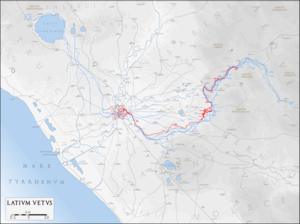Aqua Anio Vetus

The Aqua Anio Vetus was an ancient Roman aqueduct, and the second oldest after the Aqua Appia.[1] It was commissioned in 272 BC and funded by treasures seized from Pyrrhus of Epirus. Its flow was more than twice that of the Aqua Appia, and it entered the city on raised arches, supplying water to higher elevations of the city.[2]
Its construction was ambitious as it was four times as long as the Appia and its source much higher. It was clearly an engineering masterpiece, especially considering its early date and complexity of construction.
It was the first to take water from the Anio valley, hence its name.
Route
Its source is believed to be between Vicovaro and Mandela, 850 m (0.5 mi) upstream of the gorge at S. Cosimato.[3] Like the Aqua Appia, its route was mainly underground. Improvements later added bridges to take short cuts avoiding the paths along the sides of valleys by many kilometres (miles). It descended from its source along the valley to Tivoli where it left the Anio towards the Alban Hills to near Gallicano, below Palestrina. It crossed under the Via Latina near the 7th milestone and at the 4th milestone turned northwest to enter Rome.
It entered underground at the Porta Praenestina and terminated inside the Porta Esquilina. Only 5.8% of the Vetus' total supplied imperial buildings,[4] an important difference from the Appia which gave almost 22% to such buildings.
References
- ↑ http://www.romanaqueducts.info/aquasite/index.html
- ↑ Sextus Julius Frontinus. The Aqueducts of Rome. pp.1, 6–20.
- ↑ THE AQUEDUCTS OF ANCIENT ROME, EVAN JAMES DEMBSKEY, thesis 2009, 106. http://www.romanaqueducts.info/aquasite/index.html
- ↑ Frontinus